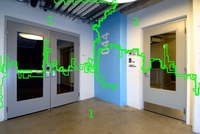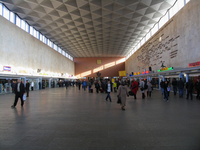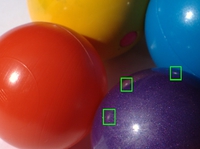Color and Reflectance
The color of an illuminant heavily influences the color appearance of digitally captured objects. Color features for high level computer vision task like recognition, tracking and detection of objects are therefore inherently dependent on the illumination conditions. The problem of neutralizing the effects of the illumination color is known as color constancy. It is typically assumed that the knowledge of the color of the dominant light source suffices to correct the image for the most disturbing illumination effects. This procedure is also known as recovering the so-called intrinsic image of a scene.
In the 1980's, Shafer introduced the Dichromatic Reflectance Model, which is the most widely used physics-based reflectance model for computer vision tasks. Algorithms for various challenges like image segmentation, specularity removal and illumination color estimation use this model to express the relationship between light and surface material and geometry. A common critique with physics-based methodologies is that they are "cute", but tend to break in real-world scenes due to their simplifying assumptions and the constraints they impose on the scene.
In our group, we examine ways to relax these constraints in order to make physics-based methodologies applicable to natural images. As a first result, we present a ![]() novel illumination estimation method that takes different votes on the illuminant color and makes a consensus decision afterwards.
novel illumination estimation method that takes different votes on the illuminant color and makes a consensus decision afterwards.
Illuminant Color Estimation for Real-World Mixed-Illuminant Scenes
 |
We present a physics-based approach for illuminant color estimation of arbitrary images, which is explicitly designed for handling images with multiple illuminants [1]. An illuminant color estimate is obtained independently from distinct image mini-regions. From these mini-regions a robust local illumination color is computed by consensus. These local estimates are then used in deriving the chromaticity of the dominant illuminants. Experiments on an established benchmark database of real-world images show that our technique performs comparable to uniform-illuminant estimation methods. Furthermore, extensive tests on real-world images show that we can reliably process mixed-illuminant scenes. ![]() The source code is available here!
The source code is available here!
References:
- C. Riess, E. Eibenberger, E. Angelopoulou: "
 Illuminant Color Estimation for Mixed-Illuminant Real-World Scenes". IEEE Color and Photometry in Computer Vision Workshop, Nov. 12th 2011.
Illuminant Color Estimation for Mixed-Illuminant Real-World Scenes". IEEE Color and Photometry in Computer Vision Workshop, Nov. 12th 2011.
Color Constancy and Non-Uniform Illumination: Can Existing Algorithms Work?
 |
A typical assumption of todays color constancy algorithms is globally uniform illumination. However, more often than not, this assumption is an insufficient approximation of real-world illumination conditions. Thus, illumination should be locally determined, taking under consideration that multiple illuminants may be present. In this paper [1] we investigate the suitability of adapting five state-of-the-art color constancy methods so that they can be used for local illuminant estimation. Each of the methods is applied independently on local pathes. We then evaluated different fusion methodologies. Our experiments indicate that the best performance is obtained by fusion strategies that combine the outputs of the estimators using regression. See the ![]() project page for additional details, source code and data.
project page for additional details, source code and data.
References:
- M. Bleier, C. Riess, S. Beigpour, E. Eibenberger, E. Angelopoulou, T. Tröger, A. Kaup: "
 Color Constancy and Non-Uniform Illumination: Can Existing Algorithms Work?". IEEE Color and Photometry in Computer Vision Workshop, Nov. 12th 2011.
Color Constancy and Non-Uniform Illumination: Can Existing Algorithms Work?". IEEE Color and Photometry in Computer Vision Workshop, Nov. 12th 2011.
Physics-Based Illuminant Color Estimation as an Image Semantics Clue
 |
 |
We investigated the behavior of the inverse-intensity chromaticity (IIC) illuminant estimation by ![]() Tan et al. [1] on real-world images downloaded from the web. The method consists of two parts: first, a specularity segmentation, and second, the estimation of the illuminant color from the segmented pixels. We found that the specularity segmentation might complicate the estimation. Furthermore, we did experiments towards a confidence measure for the illuminant color estimation. In IIC-space, the illuminant color is determined by finding the prevalent y-axis intercept of connecting lines of the points in this space. Tan et al. proposed to do this via Hough transform. Our idea was to examine the distributions in Hough space as a way towards automated self-assessment. Indeed, the distinctiveness peak in this distribution appears to give a hint on how well the specularity-segmented pixels fit the underlying physics-based model [2].
Tan et al. [1] on real-world images downloaded from the web. The method consists of two parts: first, a specularity segmentation, and second, the estimation of the illuminant color from the segmented pixels. We found that the specularity segmentation might complicate the estimation. Furthermore, we did experiments towards a confidence measure for the illuminant color estimation. In IIC-space, the illuminant color is determined by finding the prevalent y-axis intercept of connecting lines of the points in this space. Tan et al. proposed to do this via Hough transform. Our idea was to examine the distributions in Hough space as a way towards automated self-assessment. Indeed, the distinctiveness peak in this distribution appears to give a hint on how well the specularity-segmented pixels fit the underlying physics-based model [2].
In future work, we aim to expand on the analysis of these distributions towards a more robust confidence measure for this illumination estimation in IIC space.
References:
- R. Tan, K. Nishino, K. Ikeuchi: "Color constancy through inverse-intensity chromaticity space". Journal of the Optical Society of America A, vol. 21, no. 3, March 2004, pp. 321-334.
- C. Riess, E. Angelopoulou, "
 Physics-Based Illuminant Color Estimation as an Image Semantics Clue". IEEE International Conference on Image Processing, 7.11.-10.11.2009, pp. 689-692.
Physics-Based Illuminant Color Estimation as an Image Semantics Clue". IEEE International Conference on Image Processing, 7.11.-10.11.2009, pp. 689-692.
A Common Framework for Ambient Illumination in the Dichromatic Reflectance Model
 |
The dichromatic reflectance model, originally proposed by Shafer [1], is the core of most physics-based algorithms for illumination color estimation. Maxwell et al. [2] recently proposed an extension of this model, the Bi-Illuminant Dichromatic Reflectance (BIDR) model. This extension contains a term for a second illuminant. Interestingly, this extension can be seen as a theoretical fundament of several algorithms that deal with two illuminant cases. Most prominently, shadow detection algorithms often model ambient illumination as a second global light source. In our paper [3], we show connections between such algorithms via the Bi-Illuminant Dichromatic Reflectance Model. Our ultimate goal is to find a way to exploit the BIDR model directly, in order to obtain more general methods for handling two-illuminant scenarios.
References:
- S. Shafer: "Using Color to Separate Reflection Components". Color Research & Application, vol. 10, no. 4, 1985, pp. 210-218.
- B. Maxwell, R. Friedhoff and C. Smith, "A Bi-Illuminant Dichromatic Reflection Model for Understanding Images". IEEE Computer Vision and Pattern Recognition, June 2008.
- C. Riess, J. Jordan, E. Angelopoulou, "
 A Common Framework for Ambient Illumination in the Dichromatic Reflectance Model". IEEE Workshop on Color and Reflectance in Computer Vision, 4.10.2009, pp. 1939-1946.
A Common Framework for Ambient Illumination in the Dichromatic Reflectance Model". IEEE Workshop on Color and Reflectance in Computer Vision, 4.10.2009, pp. 1939-1946.


 +49-9131-85-27775
+49-9131-85-27775
 +49-9131-85-27270
+49-9131-85-27270
